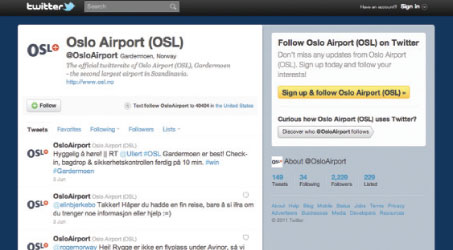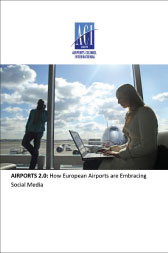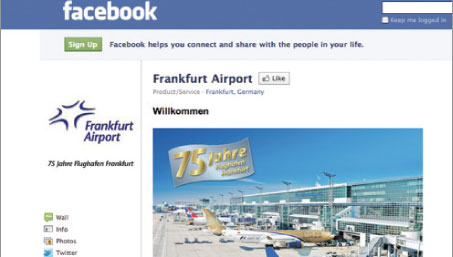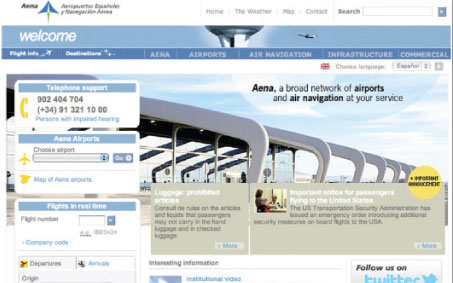As with all industry innovations, competitive pressures have ensured that social media is increasingly becoming a necessity as much as an opportunity for European airports. 64% of passengers travelling through ACI EUROPE member airports last year now have the option of connecting with their airport via social media channels.
In truth, the paths of both airports and social media have been converging for some time. As social media continues to propagate, it is playing an increasingly pivotal role in the lives of both individuals and groups across the globe, and redefining the relationships people have with each other, with businesses and with other organisations. The corporate and commercial opportunities emerging from this shift are only beginning to become clear.
Meanwhile, airports have been grappling with new competitive challenges. The business transformation outlined in ACI EUROPE’s ‘Policy Outlook’ published last year, has shown how airports are actively competing with each other to attract and retain new customers. Alongside price, airports recognise that innovation is the key to commercial success, and that the opportunities which new technologies present have to be explored and leveraged wherever possible.
Naturally, as air passengers are engaging in social media, it makes sense for airports to adopt this channel to reach out to their customers. And as with all industry innovations, competitive pressures have ensured that social media is increasingly becoming a necessity as much as an opportunity for European airports. 64% of passengers travelling through ACI EUROPE member airports last year now have the option of connecting with their airport via social media channels.

Oslo Airport’s Twitter feed has been operating for over a year, and has attracted over 2,200 followers to date.
The report

ACI EUROPE has compiled a report on airports’ use of social media, entitled ‘Airports 2.0: How European Airports are Embracing Social Media’. Published in May this year, the report examines, from a number of angles, the relationship between airports and social media which has emerged in recent times.
Picking up on this trend, ACI EUROPE has compiled a report on airports’ use of social media, entitled ‘Airports 2.0: How European Airports are Embracing Social Media’. Published in May this year, the report examines, from a number of angles, the relationship between airports and social media which has emerged in recent times.
The focus of the report is on Facebook and Twitter, as these are the two predominant social media channels, common across most airports. A 3-month survey of those airports’ Facebook and Twitter feeds was undertaken, to gather both information and insight. This was backed up with interviews with a number of communications professionals engaged in social media, across a sample of member airports.
With the information gathered, the report was divided into two, which looked at the issue from two different angles. The first section involves some number crunching, to determine who is doing what. The second section takes a more interpretive approach and tries to understand why these airports are engaging in social media, as well as how they are trying to achieve those objectives.
The report is not prescriptive, and instead simply reflects what airports are currently doing.
The numbers
The report shows that, of ACI EUROPE’s member airports, 40% of airports operate at least one social media feed. In passenger terms, 64% of passengers travelling through ACI EUROPE member airports can access a social media feed of their departure or arrival airport. This higher number reflects the fact that while regional airports are well represented, many major hubs, and some airport groups, have undertaken to provide their large passenger bases with these social media services.
The report also produces the perhaps slightly counter-intuitive result that although Twitter is more popular with users, Facebook is preferred by airports. So despite airport Twitter feeds having almost 1.75 times the number of followers than their Facebook equivalents, airports still preferred Facebook, with 82% of the airports in the survey having a Facebook profile, compared to just 70% having a Twitter account.

Fraport has a strong presence on both Facebook and Twitter, using both intensively to communicate with airport users. Facebook users are provided with current news and photos, as well as information on retail offers and services at Frankfurt Airport.
Size naturally played a role in the popularity of social media feeds, with hub airports with more than 25 million passengers per year having an average number of users almost 5 times that of smaller airports with less than 5 million passengers per year. However, on a per passenger basis, the smaller regional airports outperform their hub equivalents, showing that social media services are certainly not the natural preserve of larger airports.
Similarly, geography seems to have an impact on an airport’s social media popularity, although its effects proved difficult to pin down. The uniform success of Irish and UK airports with Twitter suggest that language at least had a strong role to play. The picture is less clear with Facebook. If there is a country-specific effect on an airport’s social media popularity, it is weak, and overridden by other factors.
The different uses of social media
As for how airports are using social media, five main uses emerged from the survey. Airports generally employ a combination of approaches across their social media feeds, and no one approach emerged as the most dominant.

Aena has embraced social media and the homepage of its website includes a link to the operator’s Twitter page, which currently has almost 10,000 followers.
Airports use social media as a customer service tool, assisting their passengers while simultaneously publically demonstrating their commitment to their customers. They used Facebook and Twitter to connect informally with their passengers, leveraging the opportunity to build a relationship which would not have existed in the absence of social media. Airports are also turning to social media for crisis management, particularly during last winter’s weather disruption, and the volcanic ash episodes of both 2010 and 2011 alongside the social media activities of EUROCONTROL. Traditional corporate communications are also being channelled via social media, allowing existing messages to be communicated to new audiences. And airports are also using social media commercially, attempting to marry digital communications with their need to drive non-aeronautical revenues.
The report also delves into some of the issues raised in discussions with airport professional communicators, such as the resources required, the risks entailed, and the future uses of social media.
The report is available online, either at ACI EUROPE’s Linked In group ‘Airports Council International European region (ACI EUROPE)’ or in the Members’ Room of the ACI EUROPE website: www.aci-europe.org.







